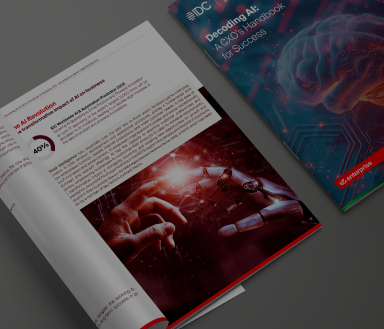Talk like a human: Why voice and conversational AI in CX are taking over
The Middle East is at a pivotal moment of digital transformation. The UAE and Saudi Arabia are spearheading AI-driven national strategies, playing a crucial role in shaping the future of industries.
The convergence of Agentic AI and the Internet of Things (IoT) is reshaping industries, unlocking new avenues for efficiency, automation, and profitability. While IoT has already revolutionised asset tracking, predictive maintenance, and smart infrastructure, the addition of Agentic AI is elevating these capabilities to an entirely new level.
Unlike AI assistants and traditional AI systems that function as reactive tools, Agentic AI is Proactive, Autonomous, and capable of driving strategic outcomes. From utilities and energy to smart cities and fleet management, vertical-specific Agentic AI solutions are enabling organisations to transition from "record now, act later" to "record and act now".
In this blog, we will explore how this synergy can foster innovation and profitability across industries.
What is Agentic AI?
Agentic AI refers to AI systems designed to operate as autonomous agents, performing tasks, making decisions, and learning with minimal human input. These intelligent systems integrate data from multiple sources and external applications to assess problems, formulate solutions, and execute tasks without constant human oversight.
Unlike basic automation, Agentic AI can:
- Sense – Perceive and collect data from sensors, cameras, and other IoT devices.
- Analyse – Conduct cognitive processing, reasoning, decision-making, and action planning.
- Control – Execute proactive actions with a feedback loop.
- Learn, Adapt & Evolve – Improve actions over time.
Is your organisation ready to adopt AI that can sense, decide, and act independently?
Agentic AI vs Traditional AI: What Sets Them Apart?
Traditional analytics and AI algorithms focus on analysing and predicting KPIs, often generating alerts when something is about to go wrong. However, it is still up to teams to interpret these signals and take corrective action.
AI agents have moved forward in the value chain. They do not stop at providing insights; they take actions to resolve the issues.
This marks a strategic shift, enabling organisations to transition from their current state to operating in "copilot" and eventually "autopilot" modes.
ROI can be realised when decision-makers get access to analysis and AI models, at their fingertips.
Don’t just analyse data - act on it. Move from AI Assistance to AI Autonomy!
Why Agentic AI is a ‘A Leap Forward’?
- Breaks down complex problems into manageable parts with AI agents.
- Enables shift from AI assistants providing insights to autonomous AI agents that solve problems and make decisions independently.
- Reduces ‘time to insights’ from months to minutes.
- Reduces ‘time to build’ from months to days.
- Continuously learns and adapts to enhance decision-making and outcomes over time.
- Controls hallucinations and autonomy, as it operates in a defined environments with clear objectives, to avoid failures.
- Ensures robust data security and compliance, minimising risks while maximising the effectiveness of AI-driven decisions.
The Role of Agentic AI in Digitally Transforming IoT Industries
Agentic AI does more than just automation – it optimises people, processes, and products. By integrating Agentic AI into IoT ecosystems, industries such as Utilities, Industry 4.0, Smart Cities, Fleet Management, Mobility, Smart Payments, and Healthcare can unlock their full potential.
According to Gartner, by 2028, 33% of enterprise software applications will include agentic AI, up from less than 1% in 2024, enabling 15% of day-to-day work decisions to be made autonomously.
Companies that invest in AI-driven IoT strategies today will accelerate innovation, transform operational strategies, enable intelligent automation, streamline processes, optimise workflows, enable strategic decision support, and enhance operational efficiency. They will lead the way in shaping a more intelligent, sustainable, and automated future by reinventing the value chain in the following ways:
Deployment– Enhancing productivity and operational efficiency at both individual and system levels with end-to-end automation.
Reshaping– Reconfiguring and reimagining workflows and functions. The shift is not about merely adding an AI layer to existing workflows, but transforming how decisions are made, how work is executed, and how value is generated. It is about human-AI collaboration that will drive value in the workplace.
Invention– Creating new products, services, and business models to improve top-line growth.
Maximising Profitability: How Agentic AI Delivers Tangible Business Outcomes
According to a report from BCG, AI agents are expected to grow at a 45% CAGR over the next five years - highlighting not just a trend, but a transformative shift in how businesses will operate and compete.
Having understood the strategic importance of Agentic AI, let’s now explore the concrete benefits it brings to businesses, from cost savings to new revenue streams.
Reduced Costs:
- Streamlined Operations: Automates decision making and tasks, reduces human errors, optimises resource utilisation and cuts operational costs.
- Faster Cycle Times: Lowering costs associated with delays and time-consuming process workflows.
- Smarter Decisions: Reduces costly mistakes with data-driven insights.
- Reduced Downtime: Autonomous adjustments to assets, improving uptime.
- Scalability: Expands operations without adding significant resources.
Increased Revenue:
- Faster Response: Minimises downtime, preventing revenue loss.
- New Revenue Streams: AI-driven innovation creates new business models.
- Enhanced Customer Experience: Improves service, growing the customer base.
Considering the immense value that it can provide for industries, 67% of the executives want to consider autonomous agents as part of their AI transformation according to a survey done by BCG.
Are you excited to know that it is not just a shiny cutting-edge technology, and it can help you drive profitability!
AI Agents Today: Assessing Adoption and Utilisation Gaps
While some organisations are actively exploring the potential of Agentic AI systems through proof-of-concepts (PoCs), widespread industry adoption remains limited.
Several factors contribute to this gap — including a lack of strategic AI enterprise ambition, shortages in specialised skills, challenges with data quality, and an unclear understanding of both the capabilities of technology and the tangible business value they can deliver
How to Close the Gap: Actions to Bridge the Agentic AI Utilisation Gap
Now that we’ve explored the strategic value of Agentic AI, let’s dive into the actionable steps you can take to fully harness its potential in your business.
- Integrate AI into Enterprise Ambition: Focus on high-impact initiatives that drive reinvention in core processes, operating models, and new offerings. Break silos to address challenges and deliver greater impact.
- Explore Cutting-Edge Technology: Explore advanced AI to unlock new revenue streams, enhance decision-making, and improve efficiency in IoT industries.
- Foster Cross-Department Collaboration: Encourage knowledge-sharing across product, engineering, and AI teams to ensure collective innovation.
- Listen to Customers: Align AI strategies with customer demands and address key business problems through intelligent process reinvention.
- Focus on High-Impact AI Use Cases: Prioritise AI initiatives that deliver measurable business value and address critical areas for improvement.
- Upskill Your Workforce: Invest in talent development to prepare your team for an AI-powered future and foster continuous innovation.
- Foster a Culture of Human-AI Collaboration: Cultivate a mindset that values AI as a tool to augment human capabilities and drive success
- Implement Robust Data Governance: Establish frameworks for high-quality, secure, and compliant data to support trustworthy AI systems.
- Plan for Scalable AI Deployment: Prepare for large-scale AI adoption with proper governance, compliance, and talent readiness.
- Measure Success with Financial KPIs: Track AI performance using financial KPIs to assess impact on profitability and optimise investments.
Where to Start: Identifying High-Impact AI Agent Use Cases
Now that we’ve outlined the key actions for AI adoption, it’s time to identify where Agentic AI can have the most significant impact in your business. Here are some questions to guide your decision-making:
- Start by asking the following questions in your industry:
- Which processes are the most time-consuming or prone to errors?
- Are there areas where decision-making relies heavily on data?
- What tasks require constant monitoring or adaptability?
- How effectively is your business using its existing data?
- Are there customer-facing challenges that could benefit from AI-driven insights?
Use these questions to identify your entry point for Agentic AI and define your strategic roadmap.
Conclusion: The Future is Now
The fusion of Agentic AI and IoT is more than a technological evolution — it’s a business imperative. By enabling autonomous intelligence, real-time decision-making, and predictive capabilities, organisations can unlock innovation, efficiency, and profitability like never before.
Businesses that embrace this transformation early will gain a competitive edge, setting new benchmarks for operational excellence and customer satisfaction.
Explore More About AI and Digital Transformation

How AI Is Reshaping The Middle East’s Future

Decoding AI: A CXO's Handbook for Success

AI-as-a-Catalyst for Digital Transformation
Let's work together
Are you ready to explore the potential of Agentic AI in your industry? Contact us for a personalised demo and see how our tailored solutions can drive your business toward its next phase of innovation and profitability.
